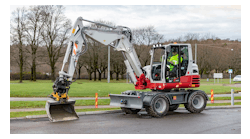Form follows function when it comes to attachments. As hydraulic excavators have evolved, replacing the cable shovels of yesterday, sophisticated, groundbreaking buckets have followed suit. Whether you need a digging implement for soft soil, which requires short, blunt teeth, or something that’s going to penetrate through rock and frost that will require pointed, longer teeth, the key component is getting the right equipment on the site. Knowing the range of functions in attachments is critical. What is the machine’s intended role? Is it backfilling, trenching, or clearing? What is the composition and density of the soil? What is the bucket’s design specification in terms of weight and power?
Form follows function when it comes to attachments. As hydraulic excavators have evolved, replacing the cable shovels of yesterday, sophisticated, groundbreaking buckets have followed suit. Whether you need a digging implement for soft soil, which requires short, blunt teeth, or something that’s going to penetrate through rock and frost that will require pointed, longer teeth, the key component is getting the right equipment on the site. Knowing the range of functions in attachments is critical. What is the machine’s intended role? Is it backfilling, trenching, or clearing? What is the composition and density of the soil? What is the bucket’s design specification in terms of weight and power?There’s an enormous variance of buckets even when it comes to widths. A narrow bucket concentrates its penetrating forces along a shorter edge and is good in hard ground. Rocket cutting buckets are shaped to create a bonnet to reduce drag and increase efficiency. Hardpan or frost buckets are designed much like the rock bucket, but with additional ripper teeth, and teeth welded to the back to loosen compacted soil. Cleanup buckets are similar to the scoop attachment minus the teeth, and have a straight, large edge best used for sloping, leveling, and backfilling. The other major category type would be the skeleton bucket, which would allow an operator to separate coarser material from finer, based on tooth width.
Stephane Giroudon is a general manager at Geith North America. He says Geith’s main users of attachments are contractors that use the heavy-duty equipment severe duty buckets for general construction site work, as well as for more demanding excavation applications involving abrasive or compact material, such as rock gravel and clay. Many customers need a deep profile for leveling and loading applications, and Geith offers up to “90 degrees of rotation from side to side, enabling contractors to complete routing tasks, such as slope finishing, land clearing, and grading with a greater ease.”
Such products are good but the customers also are looking for unique features such as heavy-duty bottom wear straps and high side plates. These features help safeguard their buckets against harmful wear patterns. Also, says Giroudon, “optional internal wear straps and additional wear shrouds, or side-cutters, provide increased strength and wear protection.” Giroudon also made the point that contractors are looking for “buckets with a dual radius shape that increase heel clearance.” They reduce drag and wear. “Customers want buckets that feature a deep profile for high capacity, and ones that have a low tip radius for greater digging leverage.”



